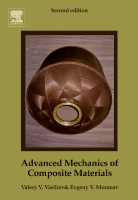Browse content
Table of contents
Actions for selected chapters
- Full text access
- Book chapterAbstract only
Chapter 1 - INTRODUCTION
Pages 1-30 - Book chapterAbstract only
Chapter 2 - FUNDAMENTALS OF MECHANICS OF SOLIDS
Pages 31-56 - Book chapterAbstract only
Chapter 3 - MECHANICS OF A UNIDIRECTIONAL PLY
Pages 57-132 - Book chapterAbstract only
Chapter 4 - MECHANICS OF A COMPOSITE LAYER
Pages 133-254 - Book chapterAbstract only
Chapter 5 - MECHANICS OF LAMINATES
Pages 255-320 - Book chapterAbstract only
Chapter 6 - FAILURE CRITERIA AND STRENGTH OF LAMINATES
Pages 321-357 - Book chapterAbstract only
Chapter 7 - ENVIRONMENTAL, SPECIAL LOADING, AND MANUFACTURING EFFECTS
Pages 359-435 - Book chapterAbstract only
Chapter 8 - OPTIMAL COMPOSITE STRUCTURES
Pages 437-480 - Book chapterNo access
AUTHOR INDEX
Pages 481-483 - Book chapterNo access
SUBJECT INDEX
Pages 485-491
About the book
Description
Composite materials have been representing most significant breakthroughs in various industrial applications, particularly in aerospace structures, during the past thirty five years. The primary goal of Advanced Mechanics of Composite Materials is the combined presentation of advanced mechanics, manufacturing technology, and analysis of composite materials. This approach lets the engineer take into account the essential mechanical properties of the material itself and special features of practical implementation, including manufacturing technology, experimental results, and design characteristics. Giving complete coverage of the topic: from basics and fundamentals to the advanced analysis including practical design and engineering applications. At the same time including a detailed and comprehensive coverage of the contemporary theoretical models at the micro- and macro- levels of material structure, practical methods and approaches, experimental results, and optimisation of composite material properties and component performance. The authors present the results of more than 30 year practical experience in the field of design and analysis of composite materials and structures.
Composite materials have been representing most significant breakthroughs in various industrial applications, particularly in aerospace structures, during the past thirty five years. The primary goal of Advanced Mechanics of Composite Materials is the combined presentation of advanced mechanics, manufacturing technology, and analysis of composite materials. This approach lets the engineer take into account the essential mechanical properties of the material itself and special features of practical implementation, including manufacturing technology, experimental results, and design characteristics. Giving complete coverage of the topic: from basics and fundamentals to the advanced analysis including practical design and engineering applications. At the same time including a detailed and comprehensive coverage of the contemporary theoretical models at the micro- and macro- levels of material structure, practical methods and approaches, experimental results, and optimisation of composite material properties and component performance. The authors present the results of more than 30 year practical experience in the field of design and analysis of composite materials and structures.
Key Features
* Eight chapters progressively covering all structural levels of composite materials from their components through elementary plies and layers to laminates
* Detailed presentation of advanced mechanics of composite materials
* Emphasis on nonlinear material models (elasticity, plasticity, creep) and structural nonlinearity
* Eight chapters progressively covering all structural levels of composite materials from their components through elementary plies and layers to laminates
* Detailed presentation of advanced mechanics of composite materials
* Emphasis on nonlinear material models (elasticity, plasticity, creep) and structural nonlinearity
Details
ISBN
978-0-08-045372-9
Language
English
Published
2007
Copyright
Copyright © 2007 Elsevier Ltd. All rights reserved
Imprint
Elsevier Science
